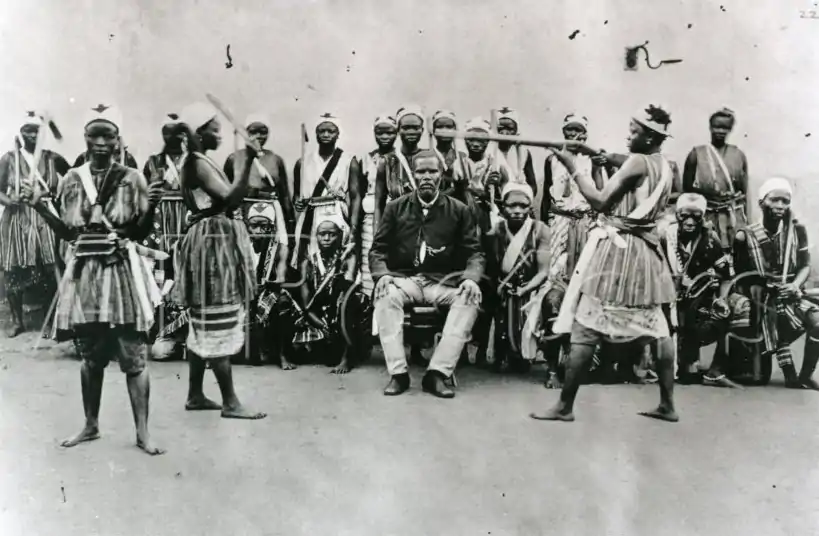First Franco-Dahomean War
The First Franco-Dahomean War, which raged in 1890, was a conflict between France, led by General Alfred-Amédée Dodds, and Dahomey under King Béhanzin. The French emerged triumphant after winning the Battle of Abomey.
| First Franco-Dahomean War | |||||||
|---|---|---|---|---|---|---|---|
 Dahomey Amazons, ca. 1890 | |||||||
| |||||||
| Belligerents | |||||||
|
| Kingdom of Porto-Novo | ||||||
| Commanders and leaders | |||||||
|
|
| ||||||
| Strength | |||||||
| over 8,000 Fon troops | 709–759 French troops, 500 Porto-Novo troops | ||||||
| Casualties and losses | |||||||
| 1,000–2,000 dead | 16 dead 83 wounded | ||||||
| History of Benin |
|---|
 |
| History of the Kingdom of Dahomey |
| Early history |
|
| Modern period |
|
|
Background
At the close of the 19th century, European powers were busy conquering and colonizing much of Africa. In what is today Benin, the main colonial power was the French Third Republic. The French had established commercial ties with the indigenous peoples of the area including one of West Africa's most powerful states at the time, the Kingdom of Dahomey. In 1851, a Franco-Dahomean friendship treaty was ratified allowing the French to operate commercially and missionaries to enter the country.[1] By 1890, the Fon kingdom of Dahomey was at the height of its power. It laid claim to almost all the coast of modern Benin plus much of south-central Benin as far north as Atcheribé. One of Dahomey's most important tributaries was the small kingdom of Porto-Novo near the coast. The kingdom had been at odds with Dahomey on and off since the middle of the 18th century.[2] In 1861, Porto-Novo was attacked by British anti-slaving ships.[2] Porto-Novo asked for and received French protection in 1863, but this was rejected by Dahomey.[2] Another issue of contention was the status of Cotonou, a port the French believed was under their control because of a treaty signed by Dahomey's representative in Whydah. Dahomey ignored all French claims there as well and continued to collect customs from the port.[2]
Cause of war
In 1874, King Tofa took power in Porto-Novo and re-established French protection over the kingdom after Dahomey attacked it in 1882.[2] Dahomey continued raiding the town, which culminated in an incident that brought the Fon and French into war. In March 1889, Dahomey attacked a village on the [[Ouémé Departm
Opening of hostilities
France responded to these events by building up its force in Cotonou to 359 men, 299 of which were Tirailleurs or French trained Senegalese and Gabonese.[3] On 21 February the French arrested the senior Fon officials in Cotonou and began fortifying the town.[3] Skirmishes with local militia also broke out.[4] It wasn't long before word of this got back to Abomey. Dahomey sent a force straight to Cotonou with plans to bring it firmly back under Fon control once and for all.
Battle of Cotonou
On 4 March a Dahomey army of several thousand charged the log stockade around Cotonou at approximately 5 in the morning.[4] This was usual for the Fon army of Dahomey that almost always marched at night and attacked just before dawn.[5] Prying apart the stakes and shoving their muskets through, the Fon fired into the enclosure.[4] Some even managed to surmount the 800-meter perimeter inflicting casualties within the walls.[3] After four hours of intense fighting, often occurring hand-to-hand despite withering French firepower and even gunboat shells, the Fon force withdrew.[4] The French sustained few losses, but the Fon suffered several hundred dead (129 within the French lines).[6]
Battle of Atchoupa
After regrouping, Dahomey sent another force south, this time toward Porto-Novo.[6] After receiving numerous reinforcements, the French ordered between 350-400 men with three field guns to march north and intercept the Fon.[6] This time, the French would be assisted by
End of hostilities
Dahomey did not launch any further attacks on Cotonou or Porto-Novo. On 3 October 1890 Dahomey signed a treaty recognizing the kingdom of Porto-Novo as a French protectorate.[7] Béhanzin was also forced to cede Cotonou, but did receive 20,000 francs a year for giving up his customs
References
- Alpern, Stanley B: Amazons of Black Sparta: The Women Warriors of Dahomey, page 191. New York University Press, 1998
- Alpern, Stanley B: Amazons of Black Sparta: The Women Warriors of Dahomey, page 192. New York University Press, 1998
- Alpern, Stanley B: Amazons of Black Sparta: The Women Warriors of Dahomey, page 193. New York University Press, 1998
- Alpern, Stanley B: Amazons of Black Sparta: The Women Warriors of Dahomey, page 194. New York University Press, 1998
- Alpern, Stanley B: Amazons of Black Sparta: The Women Warriors of Dahomey, page 150. New York University Press, 1998
- Alpern, Stanley B: Amazons of Black Sparta: The Women Warriors of Dahomey, page 195. New York University Press, 1998
- Alpern, Stanley B: Amazons of Black Sparta: The Women Warriors of Dahomey, page 196. New York University Press, 1998